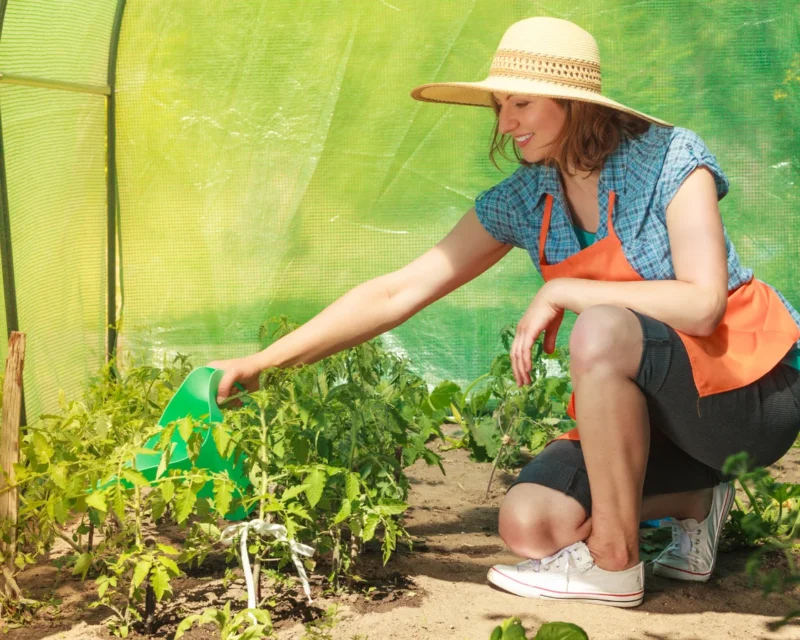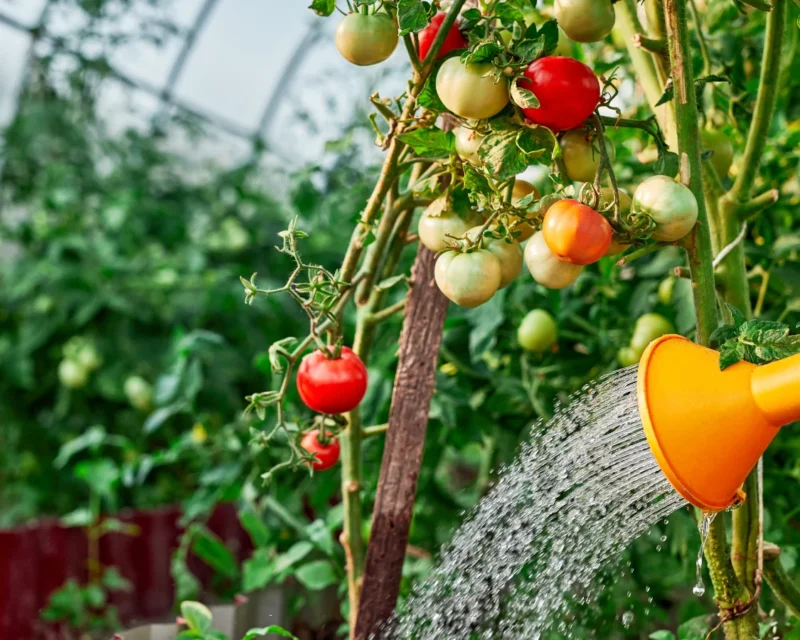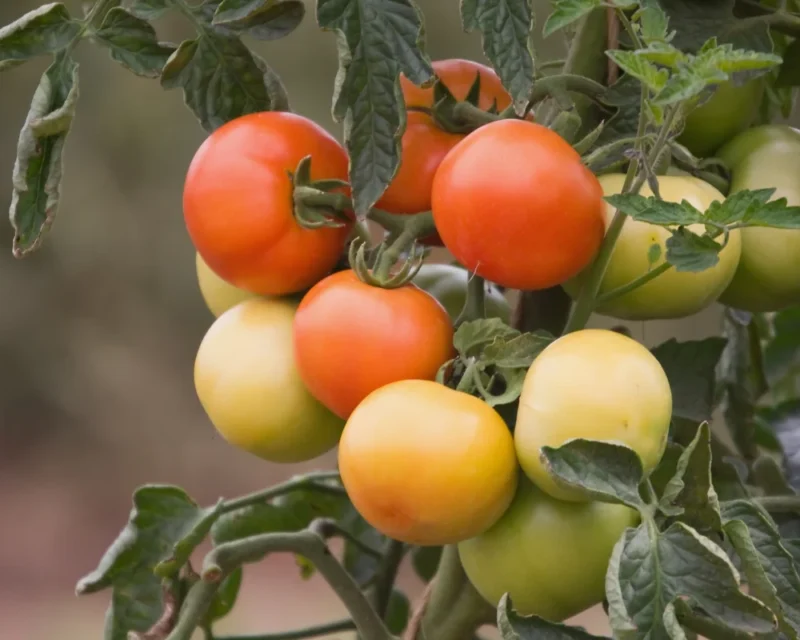Tomatoes, which are adored for their juicy, tasty fruits that can improve salads, sauces, and sandwiches, are a common addition to gardens all over the world.
One of the most important aspects to take into account while growing healthy tomato plants is their water requirements. The health and output of tomato plants depend on how frequently they are watered.
We will go into the art and science of watering tomatoes in this thorough guide, covering everything from soil types and plant stages to weather considerations and watering methods.
After reading this article, you will be equipped with the knowledge necessary to maintain your tomato plants’ health and growth throughout the growing season.
The Importance of Proper Watering

Water is a fundamental requirement for all plants, and tomatoes are no exception. Water plays several crucial roles in the life of a tomato plant:
1. Nutrient Transport: Water carries essential nutrients from the soil to the plant’s roots, allowing them to access the nutrients needed for growth, flowering, and fruit production.
2. Photosynthesis: Water is an integral part of the photosynthesis process, where plants convert sunlight into energy. Without adequate water, photosynthesis is hindered, which can stunt growth and reduce yields.
3. Temperature Regulation: Water helps regulate the temperature of tomato plants. It cools the plant through transpiration, preventing overheating during hot days.
4. Turgor Pressure: Turgor pressure is the internal pressure that keeps plant cells rigid. Proper watering maintains turgor pressure, ensuring the plant stands upright and its leaves receive adequate sunlight for photosynthesis.
With these key roles, it is obvious that giving your tomato plants the appropriate amount of water at the appropriate time is crucial for their health.
Tomato Plant Water Needs

How Often Do You Water Tomato Plants?
The unique water requirements of tomato plants is crucial before discussing how frequently you should water them. The amount of water a tomato plant needs depends on a number of factors, including:
1. Soil Type: The type of soil in your garden significantly affects how often you need to water. Sandy soil drains quickly, while clay soil retains water for longer periods of time. Loam, a balanced mixture of sand, silt, and clay, provides an ideal environment for tomato roots to access water and nutrients.
2. Stage of Growth: Tomato plants have different water needs at various stages of their growth cycle. Young seedlings require more frequent watering, while mature plants have established root systems and can go longer between waterings.
3. Weather Conditions: Weather plays a significant role in determining how often you should water your tomato plants. Hot, dry weather increases water evaporation and can lead to more frequent watering, whereas cooler, overcast days may require less.
4. Container vs. Ground: Tomato plants grown in containers may need more frequent watering since containers tend to dry out faster than garden soil. In-ground plants have access to a larger volume of soil, which can hold moisture longer.
5. Mulch: Mulching around tomato plants helps retain soil moisture, reducing the frequency of watering required. Organic mulch, such as straw or compost, also enriches the soil.
6. Variety: Different tomato varieties may have varying water requirements. Some, like cherry tomatoes, are more drought-resistant, while others, like beefsteak tomatoes, may need more water due to their larger fruits.
Now that you are aware of these elements, let’s examine the frequency of watering tomato plants at various growth phases.
Watering Frequency for Tomato Plants

1. Seedling Stage (0–2 Weeks):
Tomato seedlings are sensitive during the first stage of growth and need regular hydration to build their root systems. To keep the soil evenly moist but not soggy, water them gently.
Frequency: Water every 2-3 days, or when the top inch of soil feels dry.
2. Vegetative Growth Stage (2–6 Weeks):
As your tomato plants enter the vegetative growth stage, they will develop more robust root systems. At this point, you can start allowing the soil to dry out slightly between waterings, promoting deeper root growth.
Frequency: Water every 3–5 days, monitoring soil moisture levels and adjusting as needed.
3. Flowering and Fruit Setting Stage (6–10 Weeks):
Once your tomato plants start flowering and setting fruit, it’s essential to maintain consistent moisture to ensure the successful development of the fruit. Inconsistent watering can lead to issues like blossom end rot.
Frequency: Water every 3–4 days, keeping the soil consistently moist.
4. Fruit Ripening Stage (10+ Weeks):
As your tomatoes begin to ripen, you can reduce watering slightly to enhance fruit flavor and prevent splitting. However, don’t let the plants become too stressed, as this can lead to fruit dropping.
Frequency: Water every 4–7 days, allowing the top few inches of soil to dry out between waterings.
Signs of Underwatering and Overwatering

To gauge when and how often to water your tomato plants, it’s crucial to pay attention to the plant itself. Here are signs of both underwatering and overwatering to look out for:
Signs of Underwatering:
- Wilting leaves, especially during the hottest part of the day.
- Yellowing or browning of lower leaves.
- Stunted growth and reduced fruit production.
- Dry, crumbly soil at the root level.
Signs of Overwatering:
- Yellowing leaves that may appear waterlogged.
- Wilting, despite moist soil, is due to root rot.
- Fungus growth on the soil surface.
- Slow growth and small, pale-green leaves.
Best Practices for Watering Tomato Plants
Now that you have a good idea of how often to water tomato plants at different growth stages, let’s explore some best practices for watering:
1. Water in the Morning:
It’s generally best to water your tomato plants in the morning. This allows the foliage to dry before evening, reducing the risk of fungal diseases. Additionally, morning watering ensures the plants have adequate moisture for the day.
2. Water at the Base:
Direct the water to the base of the plant, avoiding wetting the foliage as much as possible. Wet foliage can lead to fungal issues, including blight and mildew.
3. Use a Soaker Hose or Drip Irrigation:
Soaker hoses or drip irrigation systems deliver water directly to the root zone, reducing water waste and minimizing the risk of overwatering.
4. Apply Mulch:
Mulching around your tomato plants helps conserve soil moisture, regulates soil temperature, and reduces weed growth. Organic mulch, such as straw or compost, is an excellent choice.
5. Water Deeply and Infrequently:
Provide deep and thorough watering rather than light, frequent sprinklings. Deep watering encourages deeper root growth and helps the plant withstand drought conditions.
6. Adjust Based on Weather:
Be prepared to adjust your watering schedule based on weather conditions. During hot, dry spells, you may need to water more frequently, while cool, rainy periods may require less watering.
7. Monitor Soil Moisture:
Regularly check the soil moisture level by sticking your finger into the soil about an inch deep. If it feels dry at that depth, it’s time to water.
Wrap Up
A key component of effective gardening is giving your tomato plants the right amount of water. You may cultivate healthy, fruitful tomato plants by being aware of the particular water requirements your tomato plants have at each growth stage, keeping an eye on the weather, and using the best methods for watering.
Keep in mind that when, where, and how you water are just as important as how frequently you water. You can anticipate a plentiful harvest of delectable tomatoes from your garden by mastering these elements. Enjoy your garden!




